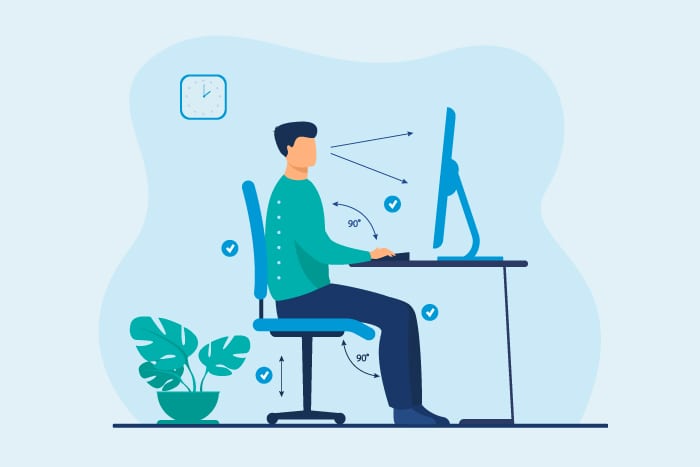Why Posture and Ergonomics Play a Role in Pain Prevention

This article aims to explore the relationship between posture, ergonomics, and pain prevention.
It begins by examining the impact of poor posture on pain and delves into the concept of ergonomics and its effects on the body.
The article further investigates how posture and ergonomics are linked to chronic pain, particularly in the workplace.
Additionally, it provides practical tips for improving posture and ergonomics in order to mitigate pain.
Finally, the article emphasizes the significance of maintaining proper posture for pain prevention.
Key Takeaways
- Prolonged use of technology leads to slouching and hunching over, causing strain on muscles and joints.
- Incorporating ergonomic principles into work environments minimizes the risk of developing chronic pain conditions.
- Maintaining good posture reduces muscle tension and prevents injuries.
- Proper desk setup is essential for maintaining good posture and preventing pain.
The Impact of Poor Posture on Pain
The impact of poor posture on pain is a significant consideration in understanding the relationship between posture and pain prevention.
In today’s technological age, where individuals spend a significant amount of time sitting and using electronic devices, poor posture has become increasingly prevalent. The prolonged use of technology, such as smartphones and laptops, often leads to slouching and hunching over, putting strain on the muscles and joints. This can result in various types of pain, including neck and back pain.
To address this issue, exercises for improving posture have been recommended. These exercises focus on strengthening the core muscles and stretching tight muscles, promoting proper alignment and reducing the risk of pain associated with poor posture.
Understanding Ergonomics and Its Effects on the Body
This discussion aims to explore the relationship between ergonomics, back pain, posture, and muscle strain.
Understanding the impact of ergonomics on the body is crucial in preventing and managing back pain.
Additionally, maintaining proper posture plays a significant role in reducing the risk of muscle strain and discomfort.
Ergonomics and Back Pain
Ergonomics and back pain are closely related and have been extensively studied in the field of pain prevention. Poor ergonomics can contribute to the development of back pain, as it places stress on the muscles, ligaments, and joints of the spine.
One of the key factors contributing to back pain is poor posture, which can be improved through the use of ergonomic office equipment. Ergonomic chairs, for example, are designed to support the natural curvature of the spine and promote proper alignment.
Similarly, ergonomic desks and computer setups can help reduce the strain on the back and neck by ensuring that the monitor is at eye level and the keyboard and mouse are positioned at a comfortable distance.
These ergonomic modifications can help alleviate back pain and promote overall musculoskeletal health.
Posture and Muscle Strain
Proper alignment of the spine and avoidance of excessive muscle strain are important factors in maintaining musculoskeletal health. Maintaining good posture is crucial for reducing muscle tension and preventing injuries.
Here are four key points highlighting the relationship between muscle tension and postural alignment:
- Increased muscle tension: Poor posture can lead to imbalances in muscle length and strength. This can result in increased muscle tension and discomfort.
- Strain on the spine: Incorrect postural alignment places added strain on the spine, causing stress on the muscles and ligaments supporting it.
- Joint instability: Improper posture can lead to joint instability, which can further contribute to muscle tension and pain.
- Reduced muscle flexibility: Chronic poor posture can lead to decreased muscle flexibility, making it more difficult for muscles to relax and recover.
How Posture and Ergonomics Relate to Chronic Pain
The relationship between posture and ergonomics and the development of chronic pain has been extensively studied in the field of pain prevention.
Ergonomics, which focuses on designing and arranging workspaces to optimize human performance and well-being, plays a crucial role in preventing chronic pain.
Posture, on the other hand, refers to the alignment and positioning of the body while performing various activities. Proper posture is essential for pain management as it helps distribute forces evenly, reducing the strain on muscles, joints, and ligaments.
By maintaining good posture and incorporating ergonomic principles into work environments, individuals can minimize the risk of developing chronic pain conditions such as back pain, neck pain, and repetitive strain injuries.
Therefore, understanding the relationship between posture, ergonomics, and chronic pain is imperative in promoting pain prevention and overall well-being.
Tips for Improving Posture and Ergonomics in the Workplace
This discussion will focus on three key points for improving posture and ergonomics in the workplace:
- Chair adjustments for comfort: Making appropriate chair adjustments can greatly enhance comfort and support, reducing the risk of musculoskeletal discomfort.
- The importance of proper alignment: Maintaining proper alignment is crucial for preventing strain on the body and promoting overall health and well-being.
- The benefits of stretching and movement breaks: Incorporating regular stretching and movement breaks can help counteract the negative effects of prolonged sitting and promote blood circulation and flexibility.
Chair Adjustments for Comfort
One important aspect to consider regarding chair adjustments for comfort is the alignment of the seat height with the individual’s leg length.
Workplace comfort is crucial for maintaining a healthy posture and preventing musculoskeletal pain. When the seat height is not properly adjusted, it can lead to discomfort and strain on the lower back, hips, and legs.
If the seat is too low, it can cause the individual to slouch and put excessive pressure on the lumbar region. On the other hand, if the seat is too high, it can result in the feet dangling, leading to increased pressure on the thighs and decreased blood circulation.
Therefore, it is important to make chair adjustments that ensure proper alignment between the seat height and the individual’s leg length to promote workplace comfort and prevent pain.
Importance of Proper Alignment
Proper alignment of chair adjustments is essential for ensuring workplace comfort and reducing the risk of musculoskeletal discomfort. The importance of alignment lies in its ability to maintain good posture, which has several benefits.
Firstly, correct alignment of the spine promotes the natural curvature of the back, reducing strain on the muscles and ligaments. This, in turn, minimizes the risk of developing musculoskeletal disorders such as lower back pain or neck strain.
Additionally, proper alignment helps distribute body weight evenly, preventing excessive pressure on specific areas and reducing the likelihood of developing pressure ulcers or joint pain.
Good posture also enhances breathing, as it allows the lungs to expand fully, improving oxygen intake.
Stretching and Movement Breaks
Regular stretching and movement breaks during prolonged sitting have been shown to improve blood circulation, reduce muscle fatigue, and increase overall employee productivity.
Incorporating stretching techniques into daily routines can help alleviate the negative effects of prolonged sitting on the body. Stretching promotes blood flow to the muscles, which can improve oxygen and nutrient delivery, as well as waste product removal. This can prevent muscle fatigue and soreness, enhancing employee comfort and well-being.
Movement breaks, on the other hand, involve engaging in physical activity during breaks from sitting. These breaks help to increase blood circulation and reduce the risk of musculoskeletal disorders associated with prolonged sitting. Furthermore, movement breaks have been linked to increased focus and concentration, leading to improved productivity among employees.
Overall, regular stretching and movement breaks are crucial for maintaining employee health and enhancing productivity in the workplace.
The Role of Posture and Ergonomics in Preventing Back Pain
Posture and ergonomics are recognized as important factors in preventing back pain. However, their impact extends beyond the back, with poor posture and ergonomics also contributing to neck and shoulder pain. Here are four key ways in which posture and ergonomics play a role in preventing these types of pain:
- Alignment: Maintaining proper alignment of the spine, neck, and shoulders helps distribute the body’s weight evenly, reducing strain on these areas.
- Muscle balance: Good posture promotes balanced muscle strength, preventing muscle imbalances that can lead to pain and discomfort.
- Joint stability: Correct posture and ergonomic positioning support proper joint alignment, enhancing stability and reducing the risk of joint-related pain.
- Movement efficiency: Optimal ergonomics facilitate smooth and efficient movement, minimizing unnecessary stress on the neck, shoulders, and back.
The Importance of Maintaining Proper Posture for Pain Prevention
Maintaining correct spinal alignment and body positioning is crucial for preventing discomfort and supporting overall musculoskeletal health. Poor posture, particularly during prolonged periods of sitting, can lead to musculoskeletal pain and contribute to the development of chronic conditions. Proper sitting habits and an ergonomic desk setup are essential for maintaining good posture and minimizing the risk of pain and injury.
Table: The Effects of Poor Posture on Musculoskeletal Health
| Sitting Habits | Desk Setup | Effects on Musculoskeletal Health |
|---|---|---|
| Slouching | Incorrect chair height | Increased strain on the spine and neck muscles, leading to pain and discomfort |
| Crossing legs | Lack of proper monitor height adjustment | Uneven weight distribution, causing hip and back misalignment |
| Leaning forward | Improper keyboard and mouse placement | Increased strain on the wrists and forearms, contributing to repetitive strain injuries |
| Sitting for long periods without breaks | Inadequate lumbar support | Compression of the spinal discs, leading to potential disc herniation |
Frequently Asked Questions
How Does Poor Posture Affect Other Areas of the Body Besides the Back?
Poor posture and improper body alignment can have detrimental effects on various areas of the body beyond the back. Muscular imbalances, joint stress, and decreased circulation are among the consequences that can arise from poor posture.
What Are the Long-Term Effects of Neglecting Posture and Ergonomics?
Neglecting posture and ergonomics can lead to long-term consequences and negatively impact overall health. Poor posture can result in musculoskeletal disorders, reduced lung capacity, digestive issues, and decreased productivity in daily activities.
Are There Any Specific Exercises or Stretches That Can Help Improve Posture?
Exercises and stretches can be beneficial in improving posture. Specific exercises and stretches designed to target the muscles involved in proper alignment can contribute to posture improvement and potentially prevent pain associated with poor posture.
How Can I Incorporate Good Posture and Ergonomics Into My Daily Routine Outside of the Workplace?
Incorporating good posture and ergonomics into daily routines can provide numerous benefits. Adopting proper body alignment and ergonomic practices outside of the workplace can help prevent musculoskeletal pain and improve overall well-being.
Can Poor Posture and Ergonomics Contribute to Other Medical Conditions Besides Pain?
Poor posture and ergonomics can contribute to various medical conditions beyond pain. Research suggests a link between poor posture and mental health issues such as depression and anxiety, as well as musculoskeletal disorders and reduced lung capacity.









